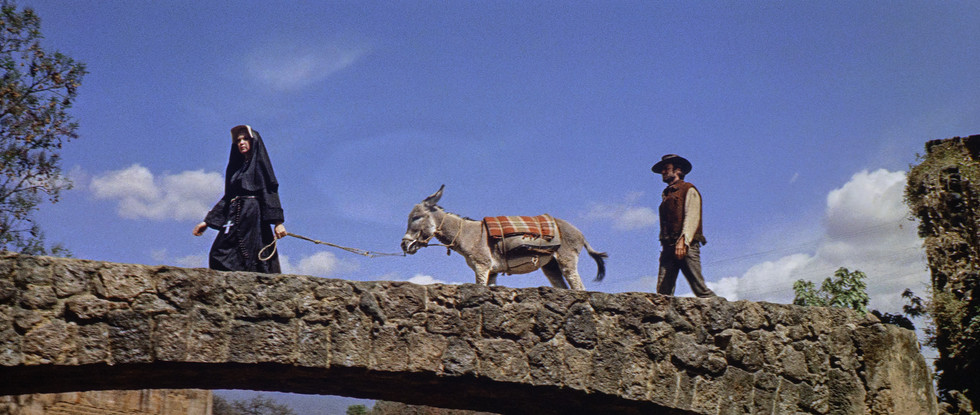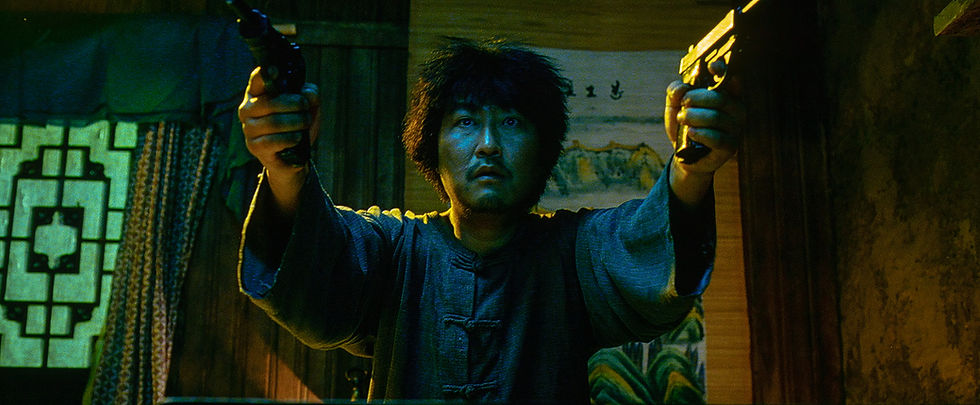Eastwood and MacLaine chemistry spark in Kino Lorber’s “Two Mules for Sister Sara” 4K Ultra HD
- Craig Shapiro & Bill Kelley III

- Nov 21, 2024
- 5 min read
4K ULTRA HD REVIEW / HDR SCREENSHOTS

Shirley MacLaine is Sister Sara, a nun – maybe – who is helping the Mexicans in their fight against the occupying French – and Clint Eastwood is the gruff, shoot-first loner Hogan.
(Click an image to scroll the larger versions)
“TWO MULES FOR SISTER SARA”
4K Ultra HD & Blu-ray, 1970, PG, gunplay, a flash of skin
Best extra: “At Home With Clint,” a vintage “interview” with Clint Eastwood (4K disc)
FOUR YEARS AGO, Kino Lorber and Universal Pictures teamed up for the first 4K restoration of Don Siegel’s western “Two Mules for Sister Sara” starring Shirley MacLaine and Clint Eastwood. Sourced from the original 35mm camera negative (2.35:1 aspect ratio) the new digital master was cleaned up removing all scratches, marks and graded in Standard Dynamic Range (SDR), which was perfect for its 2020 Blu-ray release.
VIDEO
Now, Kino and Universal have produced the definitive presentation with its 4K Ultra HD, sourced from the same 4K master with the International Edit, plus adding HDR10 and Dolby Vision grading. The expanded contrast levels provide more detail in the shadows and highlights, while the colors are more natural, with a deeper and richer palette, reducing the excess red hue found on the 1080p disc.
The overall clarity is up a couple of notches, and most evident in the gorgeous wide-angle shots of deserts and mountain peaks captured with anamorphic Panavision lens by Mexican cinematographer Gabriel Figueroa (“The Night of the Iguana”). Also, with the closeups you’ll notice MacLaine’s fair skin and trademark freckles, and with the heavy-handed eyeliner. She wasn’t happy with the excess makeup and didn’t realize the problem until days into the production. The normal dailies were delayed for days since the footage had to be shipped from the remote Mexico location to the labs in Los Angeles and then returned to Mexico.
(1) The production was mostly filmed on location in Mexico. (2-5) Hogan “intervenes” when four desperadoes try to assault Sara.
Everything was encoded onto the larger 100 GB disc, which ensured the video bitrate averaged in the low 70 Megabits per second range, while the film grain was natural and stable throughout.
The enclosed Blu-ray includes the U.S. Edit, also sourced from the 4K master, with excellent clarity, and its bitrate runs in the mid-30 Mbps.
It’s hard to imagine a more rewarding cinematic experience, as the 4K presentation is one of the best of the year.
AUDIO
Kino provides the original lossless 2.0 mono track and a juiced up six-channel DTS-HD soundtrack, as the dialogue is clear and, even better, Ennio Morricone’s (“The Good, the Bad and the Ugly,” “The Mission”) score, highlighted by the unforgettable “The Braying Mule,” theme song. The bass response is respectable when the dynamite goes off – usually with Eastwood’s cheroot providing the spark.
(1&2) French soldiers search for Sara during France’s intervention in Mexico. (3) Sara holds a rattlesnake that was beheaded by Hogan. He tells her that they can eat it. (4) MacLaine already had three Oscar nominations for Best Actress to her credit when she starred opposite Eastwood.
EXTRAS
The 4K disc includes two commentaries. You might be surprised to see MacLaine’s name listed first in the credits of an Eastwood Western directed by Siegel. In his commentary, filmmaker Alex Cox (“Repo Man,” “Sid and Nancy”) says there were two reasons. It was the “gentlemanly” thing to do, and it reflected MacLaine’s considerable star power.
No question about that.
She’d already received Best Actress Oscar nominations for “Some Came Running” and Billy Wilder’s “The Apartment” and “Irma la Douce.” After bit parts in “Revenge of the Creature” and “Tarantula” and starring on TV’s “Rawhide,” he cemented his bona fides in Sergio Leone’s iconic Man With No Name trilogy – “A Fistful of Dollars,” “For a Few Dollars More,” “The Good, the Bad, and the Ugly.”
That they were polar opposites on the political spectrum didn’t matter: Their chemistry is undeniable.
Good thing, too. In an interview from his Carmel, California home, Eastwood says that he and MacLaine share the screen for 75 percent of the running time, which played to Siegel’s mastery of pacing and timing. “Two Mules for Sister Sara” doesn’t hurt for all-out action – a railroad bridge is dynamited, and a French garrison attacked, for starters – but it’s all driven by Eastwood and MacLaine.
Well, them and a crew of other stars.
(1&2) Sister Sara stops at a shrine to pray, as she and Hogan make their way to a rendezvous with the Mexican army. (3) A French army garrison. (4-6) A French firing squad executes a villager.
Siegel, who would partner with Eastwood the next year on “The Beguiled” and “Dirty Harry” (their first project was 1968’s “Coogan’s Bluff”) had the original “Invasion of the Body Snatchers” and “The Killers” under his belt.” Albert Waltz (an Oscar nominee for “Pride of the Marines” and “Broken Arrow”) wrote the script from a story by 1950s Western director Budd Boetticher (“Ride Lonesome”).
Cox, also the author of “10,000 Ways to Die: A Director’s Take on the Italian Western,” points out that “Two Mules” was Siegel’s first foray into Mexico. It had become a go-to shooting location thanks to Sam Peckinpah (“The Wild Bunch”), John Wayne (“The War Wagon”), and other filmmakers, but Siegel steered clear of familiar locales, which also set this Western apart.
Hogan, a gruff, shoot-first loner, isn’t exactly lifted from Eastwood’s 1970 playbook, either.
He’s bringing dynamite to the Mexicans for their attack on the occupying French during the 1860s – his cause is the outpost strongbox, not independence – when he comes across some bandits about to assault the good sister (MacLaine). After he, naturally, guns them down there’s, naturally, no way they’ll split up. Sara’s wanted by the French for aiding the Mexicans, and as Hogan begins to suspect that she isn’t who she says she is, their relationship – he’s confounded and frustrated, she’s enigmatic and single-minded – develops along unexpected, often laugh-out-loud lines. It’s great fun watching them work it.
Still not convinced? Hogan has to lean on Sara big-time following a run-in with a band of Yaquis and still isn’t 100 percent when they go down to the wire to bring down a train. The results are spectacular, but he could never have pulled it off alone.
(1-3) Sara uses her cross to reflect light into the eyes of the Yaquis after Hogan is run through with an arrow.
Cox’s laidback commentary serves up some choice observations, among them how Hollywood’s cowboy code had changed by the time “Sister Sara” arrived. Where shooting someone in the back was once verboten, a “villainous protagonist” was OK, he says, as long as he was less villainous than the bad guys.
A new commentary with film historian Justin Humphrey, who avoids covering the same ground. He nicely details the final battle sequence, which involved 70 camera setups, with 120 shots, each shot wasn’t on-screen for more than five seconds.
Other extras include a poster/image gallery, TV and radio spots, and a trailer, but the highlight is “At Home With Clint,” an interview with Eastwood just before he started filming “The Beguiled.”
“Interview,” though, is probably misleading. Barely seven minutes long and done in B&W, it’s a canned promo where an unidentified interviewer’s softball questions and Eastwood’s answers were spliced in the studio. Still, it’s interesting to hear him talk about the mystique of the taciturn hero and that violence in movies can be as cathartic as attending a boxing match – interesting because, in the latter part of his career, he’s dismantled those notions.
If you’re a Clint Eastwood fan, this one’s an easy call.
– Craig Shapiro and Bill Kelley III, High-Def Watch producer
(1&2) Hogan and Sister Sara plan to dynamite a French ammunition train. (3) Hogan and Sister Sara go their separate ways to Chihuahua.
(1&2) Hogan and Sara join forces with the Mexicans when they attack a French garrison in the state of Chihuahua. (3) The cat’s out of the bag: Sara shows her true colors.




















































Comments